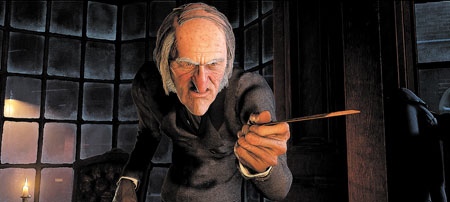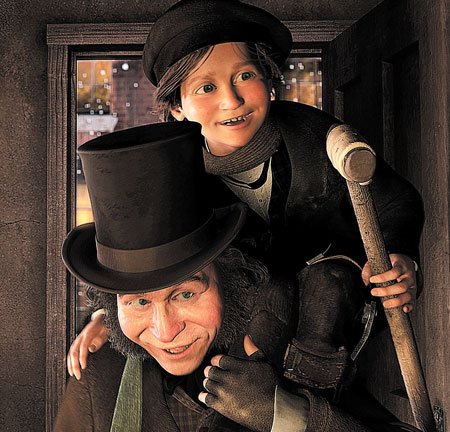‘A Christmas Carol’
Talk about the original nightmare before Christmas.
That would be the Christmas Eve doozy Ebenezer Scrooge has in "A Christmas Carol" -- a nightmare so powerful it transforms him from a holiday-hating skinflint to the embodiment of Yuletide generosity and merriment.
At least that's the Ebenezer Scrooge Charles Dickens dreamed up when "A Christmas Carol" was published in 1843 -- to mixed reviews.
More than a century later, Dickens' tale has become a beloved perennial. But its latest cinematic incarnation is doomed to receive yet another mixed review: this one.
It's not Dickens' fault, though.
This new movie is billed as "Disney's A Christmas Carol." But this holiday concoction's true author is writer-director Robert Zemeckis, who continues the romance with motion-capture animation he began in 2004 with "The Polar Express" and continued in 2007's "Beowulf."
In the motion-capture process, real actors -- from "Polar Express' " Tom Hanks to "A Christmas Carol's" Jim Carrey -- provide the movement and facial expressions for digitally animated characters.
Let me state at the outset that I despise motion-capture animation. It combines the worst of both worlds, lacking traditional animation's fanciful freedom and live action's emotional impact. Worst of all, the characters look as though they've escaped from the latest "Village of the Damned" sequel. (Their dead eyes are a dead giveaway.)
But Zemeckis clearly adores the motion-capture process, which enables him to indulge his penchant for whiz-bang computer effects without going to all the trouble of building real sets, or directing real actors on those real sets.
In theory, Carrey as Scrooge sounds like a great idea. Ideally, Scrooge's miserly coldness can be amusing -- and poignant -- as well as forbidding, and Carrey's knockabout physicality could add an intriguing dimension. Gary Oldman as Scrooge's beleaguered clerk, Bob Cratchit, seems equally inspired casting.
Other notable cast members range from Colin Firth as Scrooge's hearty nephew Fred to Bob Hoskins (star of Zemeckis' "Who Framed Roger Rabbit") as young Scrooge's even heartier boss, the fizzy Fezziwig. (There's even a mini-"Princess Bride" reunion, with both Robin Wright Penn and Cary Elwes on hand.)
Yet this "Christmas Carol" seems utterly uninterested in them, or any other characters, as anything more than window dressing. They're merely decorative figures populating its pageant of in-your-face special effects -- which are especially in-your-face if you're seeing the movie in 3-D or IMAX 3-D.
Zemeckis does restore some of the original tale's ghostly ghastliness, conjuring genuinely bone-chilling moments that are probably a bit too creepy for the little ones. (Unless, of course, they're already acquainted with the spirits who materialize at the Disney theme parks' Haunted Mansion, whom these apparitions frequently resemble.)
Little wonder that this "Christmas Carol" lacks much of the emotional warmth the tale usually delivers.
In part, that's because the Cratchits' ill but resilient son, Tiny Tim -- who's usually the heart and soul of the piece -- has been reduced to little more than a bystander. (Don't worry, folks -- he still gets to chirp, "God bless us, every one!" More than once.)
Most of the time, instead of becoming wrapped up in Scrooge's transformation -- and the characters who inspire it, from his own lonely boyhood to the ghost of his equally stingy partner, Jacob Marley -- we're busy noticing the cool snowflake effects, or the way the camera swoops and swirls as the Ghost of Christmas Present gives Scrooge (both characters played by Carrey) a bird's-eye view of Victorian London.
Visually impressive, to be sure, but it's not exactly the point of "A Christmas Carol."
Dickens' "Christmas Carol," that is.
In Zemeckis' "Christmas Carol," it's precisely the point. To which I harrumph, "Bah, humbug!"
Contact movie critic Carol Cling at ccling@reviewjournal.com or 702-383-0272.
Review
"A Christmas Carol"
96 minutes
PG; scary sequences and images
Grade: C
at multiple locations; in 3-D and IMAX 3-D at select locations
Deja View
From Mickey Mouse to Mr. Magoo, plenty of memorable performers made "A Christmas Carol" their own. A few favorites:
"A Christmas Carol" (1951) -- Originally released as "Scrooge," this British adaptation, with the incomparable Alastair Sim in the title role, still ranks as the definitive version of Dickens' Christmas classic.
"Scrooge" (1970) -- Albert Finney won a Golden Globe for his title-role portrayal in a musical version featuring an Oscar-nominated score by Leslie Bricusse.
"A Christmas Carol" (1984) -- George C. Scott's Emmy-nominated Scrooge powers a memorable made-for-TV adaptation featuring (among others) Roger Rees, David Warner and Susannah York.
"The Muppet Christmas Carol" (1992) -- Kermit the Frog, Miss Piggy and their fellow Muppets star alongside Michael Caine's all-too-human Scrooge in a Muppet-centric version.
"A Christmas Carol" (1999) -- After years of performing a one-man stage version of "A Christmas Carol," Patrick Stewart re-creates his Scrooge in a made-for-cable adaptation.
-- By CAROL CLING















